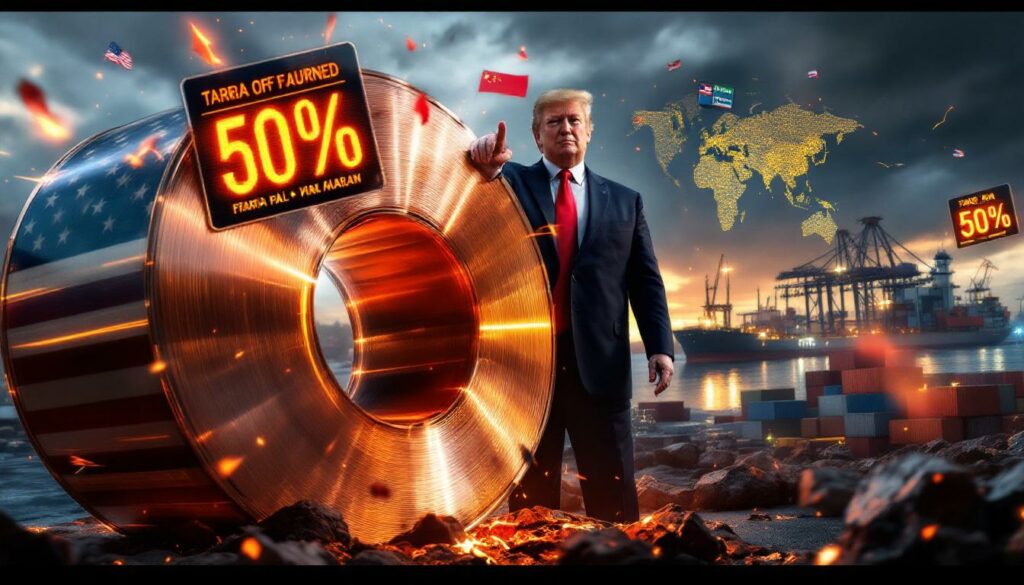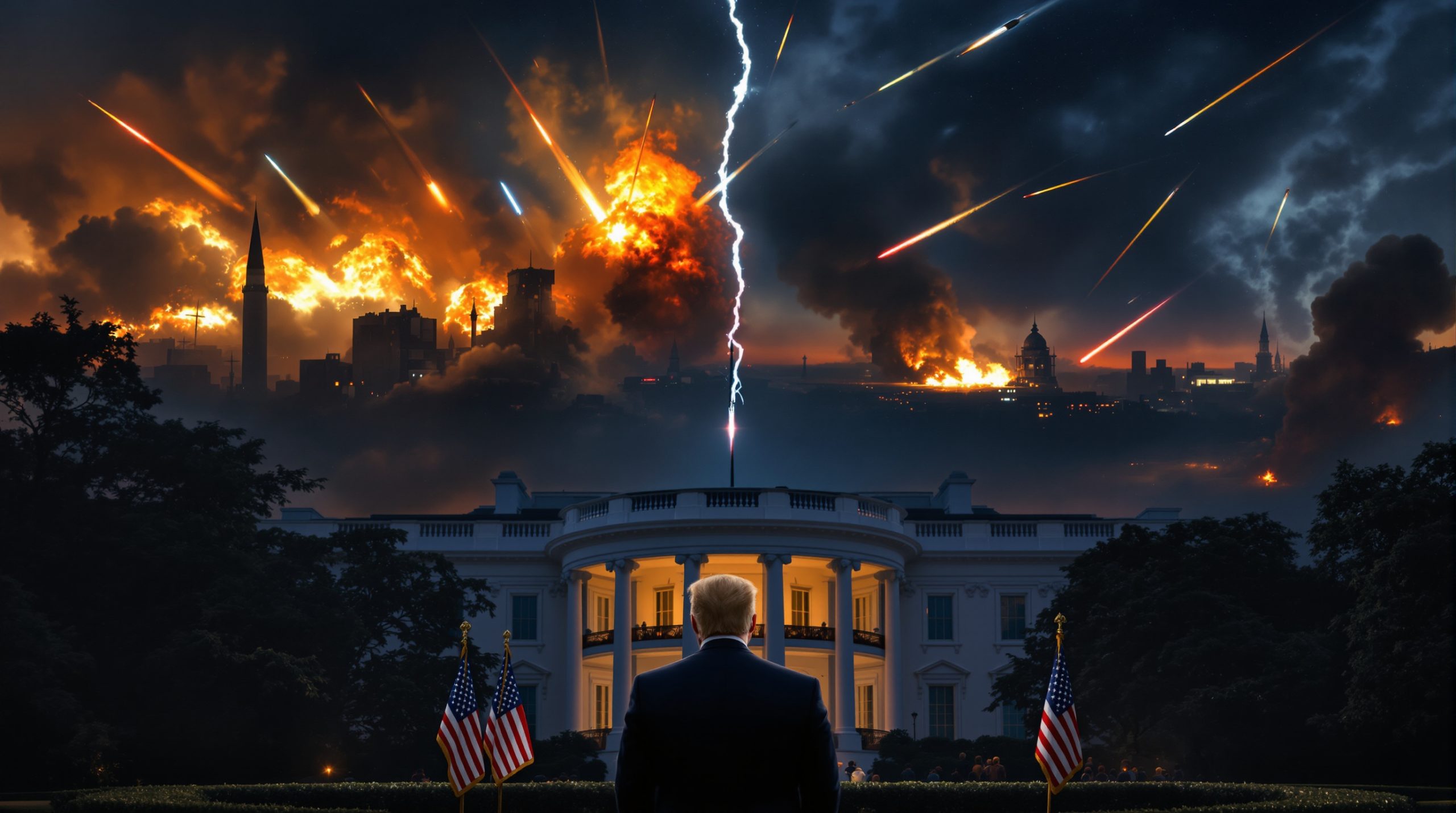Trump's Copper Tariffs Shake Global Metal Markets
In a move that has sent ripples through global commodity markets, the Trump administration has implemented substantial tariffs on copper imports. These new duties represent a significant shift in US trade policy for critical metals and have already triggered market volatility. This comprehensive analysis explores the scope, rationale, and potential impacts of these controversial copper price insights.
What Are Trump's New Copper Tariffs?
The Trump administration has imposed 50% import duties on semi-processed copper products, targeting approximately $15 billion in annual imports. The tariffs specifically focus on copper wires, tubes, rods, and cabling products while notably exempting refined copper from the duty structure.
Overview of the 50% Import Duties
These new tariffs apply specifically to the value of copper content within products, creating a variable effective duty rate depending on copper concentration. Products that are nearly pure copper will face substantially higher effective duties compared to items where copper is just one component, such as telecommunications cables.
The duties were announced in August 2025, with the official product list published in the Federal Register on August 5, 2025. The announcement triggered immediate market volatility as traders scrambled to understand the implications.
According to the Bloomberg News report, "The turmoil in the global copper market was triggered by the surprise exemption of a key form of the metal from the new US tariffs."
Products Affected by the Tariffs
Based on 2024 import figures, the tariffs target:
- Semi-processed copper products valued at $7.7 billion annually
- Telecommunications cabling (for phone and internet connections) worth approximately $7.7 billion
- Various copper-intensive manufactured goods
Notably, refined copper imports—worth $8.4 billion annually—received a surprising exemption from the tariff structure, reflecting strategic considerations around domestic manufacturing needs.
Timeline for Implementation
The implementation timeline includes:
- Initial tariff announcement in early August 2025
- Official product list publication in the Federal Register on August 5, 2025
- White House directive for an expanded tariff plan to be delivered within 90 days
- Potential future inclusion of additional copper-containing manufactured goods
This phased approach suggests the administration is testing market reactions before potentially expanding the scope of copper-related tariffs.
Why Did Trump Implement These Copper Tariffs?
The copper tariffs align with broader protectionist trade policies that have characterized the administration's approach to international commerce.
Stated Policy Objectives
In announcing the tariffs, Trump stated they "will help boost domestic output of semi-processed and copper-containing products." This statement reflects several key policy objectives:
- Boosting domestic production capacity for semi-processed copper products
- Protecting American manufacturers from foreign competition
- Strengthening national supply chain resilience for critical materials
- Addressing perceived trade imbalances in the metals sector
The focus on semi-processed products rather than raw materials suggests a strategy aimed at developing higher-value manufacturing rather than primary resource extraction.
Strategic Exemptions and Their Rationale
The exemption for refined copper—approximately 900,000 tons imported annually—represents a significant carve-out in the tariff structure. According to the Bloomberg News report, this exemption reflects "deep US reliance on imports and a pushback by key American buyers, who feared the duties would drive up tariffs impact investment markets."
This strategic exemption reveals:
- Recognition of America's dependence on imported refined copper
- Accommodation of significant industry pushback from copper-consuming sectors
- Concerns about potential inflationary impacts across manufacturing industries
- A more nuanced approach to trade policy than previous blanket tariffs
Comparison to Previous Metal Tariffs
These copper tariffs follow a pattern established earlier in 2025 when "Trump dramatically expanded the scope of US aluminum and steel tariffs by adding derivative products," according to Bloomberg News.
This approach represents:
- Continuation of protectionist trade policies established in previous years
- Evolution toward more targeted product-specific approaches
- Strategic focus on semi-finished products rather than raw materials
- Recognition of complex supply chain dependencies in metal markets
What Has Been the Market Response to the Copper Tariffs?
The announcement of these tariffs triggered immediate and significant market reactions across global copper trading.
Immediate Price Impacts
The tariff announcement caused:
- A record slump in US copper futures immediately following the announcement
- Market turmoil triggered specifically by the unexpected exemption of refined copper
- Significant volatility in trading as market participants reassessed positions
- Widespread unwinding of speculative positions, contributing to price movements
These market movements reflect both the direct impact of the tariffs and the uncertainty created by partial implementation and potential future expansions, possibly leading to a copper price collapse according to some analysts.
Supply Chain Disruptions
Market participants have responded with:
- Increased London Metal Exchange (LME) copper stockpiles as traders unwind tariff-related positions
- LME readily available copper inventories jumping to their highest levels since March 2025
- Price slippage of approximately 0.6% following these inventory increases
- Widespread reassessment of supply chain strategies across copper-dependent industries
The US copper market is still "scrambling to understand" the implementation implications, according to market observers cited in the Bloomberg report.
Industry Response and Adaptation
Industries are adapting through:
- Comprehensive assessment of cost implications for copper-intensive products
- Evaluation of potential shifts in sourcing strategies to minimize tariff impacts
- Domestic producers examining capacity expansion opportunities
- International suppliers developing tariff mitigation strategies
The variable tariff structure—based on copper content percentage rather than product weight—creates complex calculation challenges for importers and manufacturers.
How Significant Is the U.S. Copper Import Market?
The United States represents a major global copper consumer with substantial import dependencies across various product categories.
Scale of U.S. Copper Imports
US International Trade Commission data cited by Bloomberg News reveals:
- Approximately 600,000 tons of semi-finished copper imported annually
- About 900,000 tons of refined copper imported yearly (now tariff-exempt)
- Total import value exceeding $23 billion across all copper product categories
- Significant dependence on imports for both raw and semi-processed copper
This import dependency highlights the strategic importance of copper to the US economy and explains the careful calibration of tariff policies.
Key Trading Partners Affected
While specific country-level data wasn't provided in the source material, the tariffs will impact:
- Multiple international copper suppliers with varying exposure based on product mix
- Nations specializing in semi-processed copper products facing greater tariff burdens
- Countries exporting refined copper enjoying tariff exemptions
- Trade relationships with major copper-exporting nations facing potential strain
The selective application of tariffs creates winners and losers among international suppliers, potentially reshaping global copper supply forecast scenarios.
Strategic Importance of Copper Supply
Copper's critical importance stems from its essential role in:
- Electrical infrastructure and renewable energy technologies
- Telecommunications and electronics manufacturing
- Defense applications and national security
- The ongoing green energy transition and electrification initiatives
These strategic considerations likely influenced the nuanced approach to tariff implementation, balancing protectionist impulses against practical supply chain realities.
What Are the Potential Economic Consequences?
The economic impacts of these tariffs will vary significantly across industries and product categories.
Inflationary Concerns
Potential inflationary pressures include:
- Price increases for copper-containing consumer products
- Higher input costs for American manufacturers using semi-processed copper
- Possible pass-through effects to construction, electronics, and automotive sectors
- Varying impacts based on copper content percentage in finished goods
The Bloomberg report notes that "semi-processed products that are almost pure copper will attract a much higher effective duty than, say, internet cables where the copper wiring is only a part of the product." This variable impact creates complex pricing challenges across supply chains.
Manufacturing Competitiveness
Competitive impacts will likely include:
- Increased costs for US manufacturers requiring imported copper components
- Potential advantages for domestic copper processors and fabricators
- Competitive challenges for export-oriented manufacturers using copper inputs
- Sector-specific impacts varying by copper intensity and product positioning
The exemption for refined copper may moderate some competitive impacts while still creating advantages for domestic processing operations.
Employment and Investment Effects
Potential employment and investment impacts include:
- Job creation opportunities in domestic copper processing and fabrication
- Possible employment challenges in downstream manufacturing if costs rise significantly
- Investment incentives for expanding US copper processing capacity
- Uncertainty affecting capital allocation decisions across the supply chain
Industry Insight: The variable tariff structure creates complex calculation challenges for importers. Companies must now determine the precise copper content percentage in each product to accurately assess tariff liability, potentially requiring new testing and documentation procedures.
How Might International Trade Relations Be Affected?
The copper tariffs represent a significant trade policy shift with potential international implications.
Potential Retaliatory Measures
International responses could include:
- Counter-tariffs from affected copper-exporting nations
- Escalation of trade tensions with major trading partners
- World Trade Organization challenges to the tariff regime
- Complications in bilateral and multilateral trade negotiations
The selective nature of the tariffs—hitting semi-processed products while exempting refined copper—may influence the scope and targeting of any retaliatory measures.
Global Supply Chain Realignment
Supply chain adaptations may include:
- Reshoring of copper processing operations to the US
- Redirection of copper product flows to avoid tariffs
- Development of alternative supply chains for affected products
- Strategic repositioning by international suppliers to maintain market access
The 90-day timeline for potential expanded tariffs creates an urgent incentive for supply chain managers to develop contingency plans.
Long-term Market Structural Changes
Structural market changes could include:
- Acceleration of regional supply chain development
- Increased emphasis on domestic resource development and processing
- Emergence of new trading patterns for copper products
- Evolution of pricing mechanisms to account for tariff-related market segmentation
These structural changes may have lasting impacts beyond the immediate tariff implementation period.
What Should Businesses and Investors Watch For?
The evolving nature of the tariff implementation creates both risks and opportunities for various stakeholders.
Key Indicators to Monitor
Critical indicators to watch include:
- Implementation details for the expanded tariff plan (due within 90 days)
- Inventory levels and price spreads between US and international markets
- Announcements of domestic capacity expansions or acquisitions
- Policy signals regarding potential exemptions or modifications
The LME inventory levels provide an early indicator of market adjustments, with the Bloomberg report noting inventories had already "jumped to the highest since March."
Strategic Considerations for Different Stakeholders
Different market participants face varying strategic imperatives:
For Copper Producers:
- Evaluate opportunities for domestic expansion and increased pricing power
- Assess competitive positioning relative to tariff-exempt suppliers
- Consider vertical integration to capture more value-added processing
For Manufacturers:
- Develop supply chain diversification strategies
- Implement cost management approaches for copper-intensive products
- Evaluate product redesign options to reduce tariff exposure
For Investors:
- Analyze sector-specific impacts and competitive positioning shifts
- Identify potential winners and losers across the copper value chain
- Monitor ASX copper stocks impact as markets adjust
For Traders:
- Explore arbitrage opportunities between tariff-affected and exempt products
- Develop inventory management approaches responsive to changing trade flows
- Position for potential price volatility during implementation transitions
Potential Policy Developments
Policy evolution may include:
- Refinements to tariff implementation based on market feedback
- Targeted exemptions for specific applications or industries
- International trade negotiations affecting copper product classifications
- Congressional or legal challenges to tariff implementation authority
The 90-day timeline for expanded tariff planning creates a critical window for industry advocacy and policy engagement.
Frequently Asked Questions About Trump's Copper Tariffs
Why were refined copper imports exempted from the tariffs?
The refined copper exemption reflects several key factors:
- Deep US reliance on imported refined copper (approximately 900,000 tons annually)
- Significant pushback from key American industrial consumers
- Concerns about substantial inflationary impacts across manufacturing sectors
- Strategic focus on encouraging domestic processing rather than primary production
According to Bloomberg News, the exemption acknowledges "deep US reliance on imports and a pushback by key American buyers, who feared the duties would drive up costs significantly."
How do these tariffs compare to previous metal trade actions?
These copper tariffs:
- Follow a similar pattern of expanding aluminum and steel tariffs to derivative products
- Represent a more targeted approach focusing on specific product categories
- Demonstrate evolution in protectionist trade strategy
- Reflect continued emphasis on domestic manufacturing protection
Bloomberg News notes that "Trump dramatically expanded the scope of US aluminum and steel tariffs earlier this year by adding derivative products," establishing a pattern now extended to copper.
What industries will be most affected by these tariffs?
The most significantly impacted sectors likely include:
- Telecommunications equipment manufacturers using copper cabling
- Electrical equipment producers utilizing copper wiring and components
- Construction industry relying on copper tubing and fixtures
- Electronics manufacturers incorporating copper components
The variable impact based on copper content percentage means products with higher copper concentration face proportionally higher effective tariff rates.
Could these tariffs lead to domestic copper shortages?
Supply constraints may vary by product category:
- Limited risk for refined copper due to tariff exemptions
- Potential supply constraints for specific semi-processed products
- Likely transition period as supply chains adjust to the new tariff regime
- Domestic capacity expansion may lag behind immediate demand shifts
The market will be closely watching inventory levels and capacity announcements for signals about potential supply constraints.
Disclaimer: This article contains information about trade policies that may change rapidly. The economic impacts discussed represent potential outcomes based on current understanding and historical precedents. Readers should consult with qualified financial and legal advisors before making business decisions based on tariff impacts.
Future Outlook for Copper Markets Under New Tariff Regime
The implementation of these tariffs marks just the beginning of what could be a significant restructuring of global copper trade flows. The 90-day timeline for potential expansion creates an urgent strategic planning imperative for affected industries. Companies throughout the copper value chain are reassessing sourcing strategies, manufacturing locations, and product designs in response to this new trade landscape.
While the immediate market response has focused on price volatility and inventory adjustments, the longer-term impacts may be more structural—potentially including reshoring of processing operations, development of tariff-optimized product designs, and emergence of new trading relationships that minimize tariff exposure.
As with previous metals tariffs, the actual economic impacts will likely be more complex and nuanced than initially anticipated, with both unexpected challenges and opportunities emerging as implementation proceeds. Businesses that develop flexible, responsive strategies will be best positioned to navigate this evolving trade environment.
Ready to Gain an Edge in Copper Investment Opportunities?
Don't miss potential opportunities in the evolving copper market. Explore Discovery Alert's dedicated discoveries page for insights on significant mineral discoveries and their market impact, powered by our proprietary Discovery IQ model: https://discoveryalert.com.au/discoveries/




